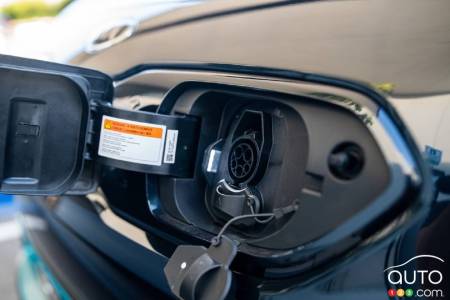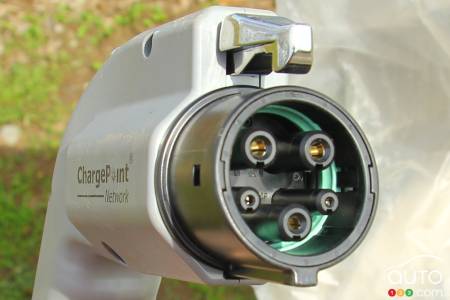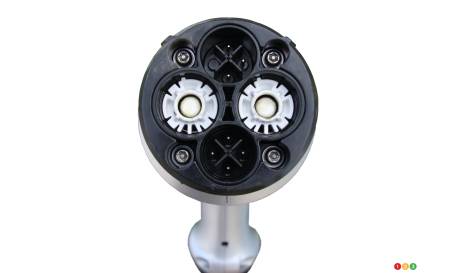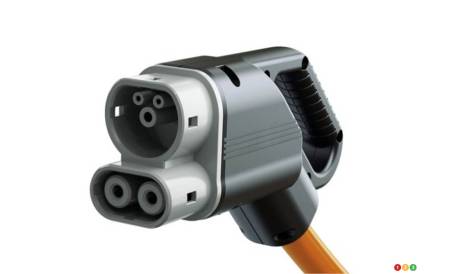
Auto123 puts the Kia Niro EV to the long-term test. Today, part 12.
Today I want to talk about charging connectors. Charging nozzles, some folks call them. Charging guns, some other folks call them. Not the lethal weapon kind, of course, but rather the sort that gives life to your EV’s battery pack. The sort you see hanging from the side of every public charging station, or maybe lying on the ground if the previous user was a slob.
The Cable Guy
Every Niro EV comes with a charging cable of about 12 feet in length. At one end, you have the three-pin plug that goes into your home outlet; at the other end, you have the charging connector, or nozzle, or gun. Between the two, you have a box, which is an adaptor the cable runs through, and which regulates the voltage of the electricity.
For months now, I have been plugging the tip of the connector into the socket on the front of the vehicle. A simple push of the fingers and the door opens. The nozzle is protected by a cap. Remove it and stick the connector in the nose of the Kia.
It’s best not to be shaking when you do this, or have had a few drinks. Because the tip engages as long as you align it perfectly; the slightest wrong angle and it won’t work. Fortunately, the cover of the plug is equipped with a light, very practical when you’re connecting your EV at night.
Once the connection is secure, the Niro EV makes a few reassuring clicks, and the indicator lights on top of the dashboard light up. A very good sign! It means that charging has just begun.
That is, of course, if the other end of the cable is plugged into a wall outlet. At my house, that’s a simple 120-volt household outlet. If the Niro's 64-kWh battery is completely discharged, make sure you’re equipped with the patience of Job, because charging the Niro EV to 100 percent on a regular outlet will take you… 60 hours.
This form of charging is called Level 1. And while it’s better than nothing, it’s only slightly so.

You'll be excited to know that Level 1 connector is poetically named J1772 (see image). It's available on all EVs sold in North America, with the exception of vehicles made by Tesla, which never does anything like everyone else, but nevertheless provides an adapter to its owners.
Important aside: the cable on the Niro EV (and, for that matter, other EVs) should not be used every day in the long run for all-electric vehicles. At least that's the opinion of Yannick Lemelin, customer service coordinator at BEQ Technology, a distributor and installer of charging stations (of several brands), and soon to be manufacturer's agent (an important announcement on that subject will come in the spring).
According to Yannick, this cable should be considered a “spare tire” type of deal. He was tempted to say “jerry can” but he thought better of it (perhaps calculating it wouldn’t do for someone in the electric mobility sector to use an expression taken from the petroleum domain!).
Sure enough, Kia itself refers to the default Level 1 cable as an “occasional charging cable”.
Why? Because “intensive (ie, daily) use might lead you to have to replace it,” warns Yannick. “And since it can cost between $1600 and $2800, depending on the manufacturer...”.
Take note, however, in the case of PHEVs (plug-in hybrids), daily use of the manufacturer's cable is not a problem.

Faster please!
Level 2 charging occurs when you turn to 240 volts (like your stove uses); this is what you get when you have a standard charging station installed at home. Here again, the J1772 charging connector does the job.
Then you come to Level 3, the fast charge available on public charging stations (DC fast-charging systems, as opposed to the alternating currents of 120v and 240v outlets). And on those Level 3 stations, there are three types of connectors or nozzles.
First of all, there’s the connector used in Tesla's Supercharger network, which is currently reserved in North America for Tesla owners - although this could change following a European law that requires Tesla to make its charging stations accessible to all EVs.
Next is the CHAdeMO connector (see image) popularized by the Tokyo Electric Power Company. CHAdeMO stands for "Charge to Move" or, as dubbed by Stellantis, a Charge'N'Go. If you drive an Asian-made EV (South Korea included), you use the CHAdeMO nozzle.
Finally, the CCS Combo nozzle (see image), for Combine Charging System, although sometimes the letters SAE replace the acronym CCS. As the name suggests, it combines Level 1, 2 and 3 connectors.
All fast-charging stations include a CHAdeMO and CCS Combo gun. This way, all EV drivers can find satisfaction at a station, regardless of the nationality of their vehicle.
Another thing worth noting: “As soon as one of the two connectors at a station is activated, the other cannot be used,” explains Yannick. In other words, a single public charging station only handles a single EV at a time.

On the way to standardization
Because the CHAdeMo plug cannot accept electrical power in excess of 50 kWh, newer EVs are moving away from the CHAdeMo plug to the CCS Combo which can handle up to 350 kWh.
In fact, for the sake of standardization, Asian automakers are now adopting the CCS connector. Even Nissan, one of the main initiators of the CHAdeMO standard, has decided to equip its new Ariya with a CCS Combo plug. Which the Niro EV already has.
“One day, when all the pre-2020 Asian EVs have been taken off the road, there will only be CCS left,” Yannick predicts.
If this reminds you of the struggle between Betamax and VHS videocassettes, you're of a certain age, but you’re also not alone. That said, the similarity is only skin deep. Beta was better, according to the experts, but VHS won thanks to better marketing. The war of the charging connectors is different: “In the battle between CHAdeMO and CCS, you can't say one is better than the other,” says Yannick.
On the other hand, not all public charging stations are born equal. As we'll see next time.
Specifications sheet of KIA Niro EV
See also: Kia Niro EV Long-Term Review, Part 1: The carmaker, the reviewer and the (young) enthusiast
See also: Kia Niro EV Long-Term Review, Part 2: Electric cars, a new idea with a long history
See also: Kia Niro EV Long-Term Review, Part 4: Getting a charge out of charging
See also: Kia Niro EV Long-Term Review, Part 5: Many kilometres, many questions
See also: Kia Niro EV Long-Term Review, Part 6: When the computer decides things, without consulting us
See also: Kia Niro EV Long-Term Review, Part 7: Off to Join the Electric Circuit
See also: Kia Niro EV Long-Term Review, Part 8: The Benediction
See also: Kia Niro EV Long-Term Review, Part 9: Beating the Cold
See also: Kia Niro EV Long-Term Review, Part 10: Let’s Talk Maintenance
See also: Kia Niro EV Long-Term Review, Part 11: Questions… and Answers


